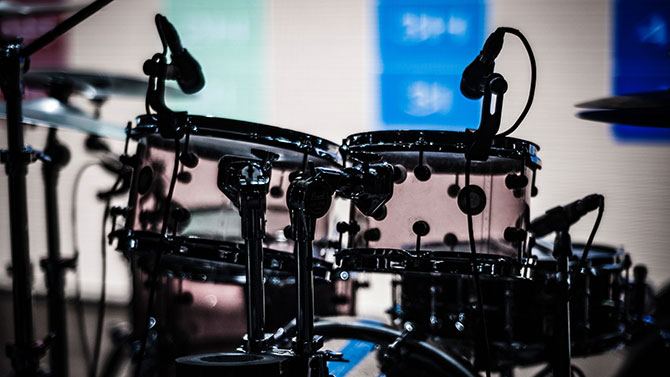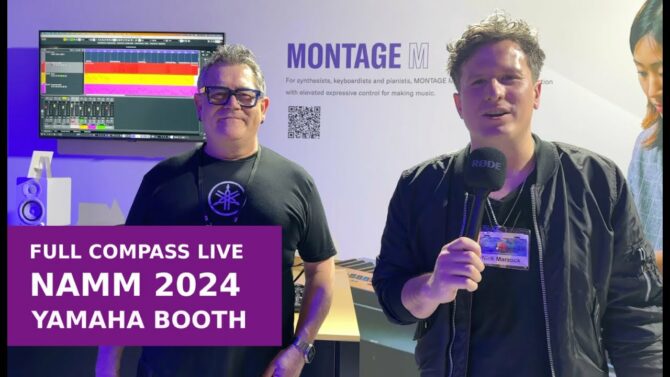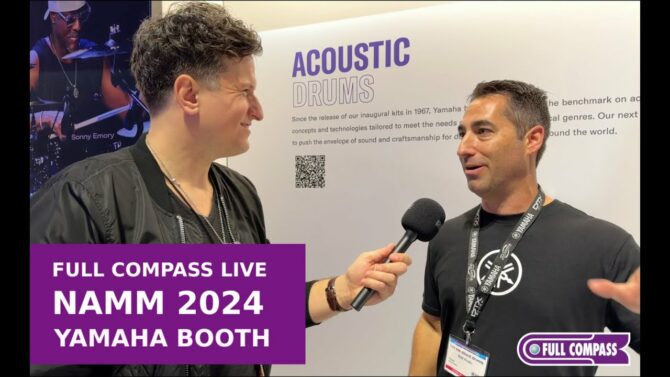This is a continuation of a series. If you have not yet read them, please check out Part 1 and Part 2 here.
The Best Models and Methods for Close-Miking Each Instrument
Sometimes it’s best to get up close and personal with the audio you are recording. What are you trying to capture with each microphone and its placement? Is the ambience of an environment or an audience’s reaction relevant? Or do you want the extreme clarity and truthfulness of a microphone situated very close to the sound source?
Close-miking a voice or an instrument can allow you to obtain a clean, precise audio recording, minimizing acoustical feedback and reflective sound, but each choice of microphone and its placement will change the flavor of the recording. And different instruments will benefit from different models and placements and proximities.
Drums – Many Percussive Possibilities
It’s entirely possible to capture the sound of a full drum kit with only two or three mics – many prominent producers did exactly that, particularly on classic 50’s and 60’s recordings. Today’s producers more typically record drums with a combination of stereo Definition:
Definition:
A two channel signal simulating a sound space, typically played through two speakers. overheads while close-miking Definition:
Definition:
Typically placing a microphone less than a foot from the sound source. the individual kit pieces, all with directional patterns to minimize cross-talk/leakage. The overheads provide the sound of the cymbals plus the entire kit, but with a thinner, more mid-range-y tone than your typical modern drum sound. It’s the close mics that bring that fat yet crisp presence Definition:
Definition:
An EQ effect that boosts audio, typically between 2 kHz to 7 kHz, to add clarity and articulation. to the individual drums that we’ve all gotten used to ever since the era of multi-track recording began in earnest in the early 70’s.
Let’s start with the basic arrangement - dynamic mics on the drums, with condensers for the hi-hat and the overheads, but there are no rules, and many engineers use condensers even on the individual kit pieces. Dynamics Definition:
Definition:
In a musical performance, changes in overall volume levels, often accompanied by timbral changes. Example: Classical symphonic music has a wide dynamic range, while dance mixes have a much narrower dynamic range. provide a nice punch, while condensers offer a bit more clarity and detail.
The go-to mic for the snare is the Shure SM57, a uni-directional, dynamic model placed anywhere from an inch to several inches above the drum, either pointing down at the edge of the drum, or aimed towards the center. Many engineers also mic up the snare from the bottom (ideally recorded on a separate track), using a condenser Definition:
Definition:
An archaic term for Capacitor. instead of another dynamic.
The toms are miked up individually, using the same techniques as the snare,with either the Shure SM57 or Sennheiser 421’s, which provide a bit more top and bottom end. Once again, a condensed microphone like the Audio-Technica ATM450 can be used for both snare and toms when extra clarity and openness is desired over punch.
Miking the kick depends on whether the front head is left on or removed. For a more traditional two-headed sound, a mic a foot or two in front of the front head will capture a nice round sound. Alternatively, a hole might be cut in the front head, and the mic positioned just inside, or the front head may be removed altogether and the mic pushed inside closer to the back of the batter head, for greater attack. Often a second mic is also used, either a couple feet in front, for more air, or by the batter head where the beater hits, for extra snap. As far as mic choices, mics with more extended low-end response are usually preferred.
All About That Bass
It’s common for the bass to be recorded as both a Direct Input signal for depth and clarity, and with a mic on the bass amp Definition:
Definition:
Abbreviation for either Ampere or Amplifier. for grit and punch. The same mics recommended for the kick drum are usually good for miking the bass amp as well, typically placed an inch or so from the speaker grille, anywhere between the center of one speaker’s cone (bright, presence) to the edge of the surround Definition:
Definition:
Multiple speakers place around a listening area to create an enveloping soundscape. (darker, warmer).
When it comes to the upright bass, a condenser mic with good bass extension such as the Microtech Gefell M297 a foot or so out, aimed near the bridge, should get the job done, but this may not always be possible. Upright bass is a relatively quiet instrument, typically used in ensembles of significantly louder instruments, and so very-close miking may be required to avoid excessive leakage.
Electric Avenues
Conventional wisdom calls for placing a uni-directional, dynamic an inch or so from the grille, positioned by ear. It’s the classic approach, but not the only one. Different mics will bring out different aspects of the guitar tone - bright, punchy, nasal, full, warm - any of the mics already mentioned, or any of the many similar dynamics or condensers could be a good choice. For a warmer, smoother tone, a ribbon mic like the Royer R10 (offers a great spectrum of options) can often do the trick - just remember that when positioning ribbons, even the ones that look like pencil condensers are actually side-address mics.
A second mic, at a distance of a foot or two (or three) is often used to capture more of the sound of the amp loading the room, bringing in that thump and slap that subliminally lets the listener know that the amp is cranked and really pushing it - a potentially more exciting sound, even before resorting to mix processing.
Acoustic Guitars and Strings
Condensers are your best choice to capture the brightness and snap of the strings and the air and resonance Definition:
Definition:
1. (physics) The phenomenon of a signal's amplitude increasing when its frequency is close to the natural frequency of a system of which it is a part, or on which it acts. 2. (filter) A control that increases amplitude at whatever frequency is selected. from the body. Small-diaphragm Definition:
Definition:
The moving portion of a microphone that transforms sound waves into motion that can ultimately produce electrical waves. pencil mics like the CAD Audio GXL 1200 are probably the most popular choices, but large-diaphragm condensers like the pricier Audio-Technica AT5040 will work equally well, bringing their typically more pronounced upper-midrange presence to the task.
Usually, most engineers will start by positioning the mic about a foot in front of the guitar, aimed at the twelfth fret, and then adjust the position and angle between there and closer to the bridge - the twelfth-fret position favors the strings, for a bright, strummy sound that sits well in a mix, while moving closer to the bridge may offer more body resonance, for a fuller tone. Try to avoid pointing the mic directly at the sound hole, as this can be prone to picking up too much “boom”.
It’s also common to add in a second mic. Two mics could simply be configured as a stereo pair, for a wider, more ambient Definition:
Definition:
- Something in a close vicinity.
- The natural sound of a space, or simulation of being in that space.
effect. Often the second mic is either positioned a little further away, for extra room tone Definition:
Definition:
Background room sound, often recorded in solation to intercut with dialogue for consistent sonic ambiance., or with one mic favoring the strings and the other the body for a potentially richer tone, optionally recorded on separate tracks and blended to taste in the mix.
Other strings, such as mandolin, banjo and ukulele, respond well to the same approach but many of these are much more resonant than acoustic guitars, so the choice of mic may need to reflect that. A mic with a strong upper-midrange peak (like a typical vocal condenser) may result in too much “glare” And a smoother, more subdued model (some pencil mics or reference mics) might work better, especially if combined with a slightly more distant placement.
Brass and Winds
Flutes, clarinets and other classical winds, and saxophones - are typically miked up with a condenser around a foot above or in front of the instrument, typically aimed somewhere around the center of the instrument (the holes) rather than directly at the mouthpiece area. However, in some playing styles the player’s breath noise is an important part of the sound - think of a jazzy flutist, or a breathy sax on a ballad. In those cases, miking up the mouthpiece may be in order to better capture that stylistic attribute. Normally, I’d advise against sticking a mic down the bell of a sax (except in some live on-stage situations) - most of the sound, at least the most well-balanced sound, comes from the holes, and a bell mic will often capture way too much honk.
Bell brass instruments such as a trumpet or trombone are usually addressed with a mic a foot or so in front, pointing straight at the bell (or further back, and even slightly angled, if the sound is too focused and leakage is not a problem). Here, pretty much all types of mics are widely utilized, and each brings its own benefits: dynamics handle the air pressure well when closer positioning is used; condensers provide the brightest, crispest sound; and when the sound is too bright & crisp, ribbon mics are a popular choice, for a more mellow, and potentially more well-balanced tonal character.
Kapturing Keyboards
Generally, acoustic piano is miked in stereo using small or large-diaphragm condensers, with placements from a few inches above the strings (rock/pop), to the edge of the piano case (jazz), to a few feet away (classical). The Hammond organ is recorded with mics on its companion Leslie Definition:
Definition:
A classic brand of rotating speaker popular with Hammond organs, and trademarked by Hammond Suzuki. speaker, typically a stereo pair pointing at the high-frequency Definition:
Definition:
A value, expressed in Hertz, that indicates how many cycles of a periodic signal occur in one second. horn, and one or two mics aimed at the low-frequency rotor. To capture as much of the swirling effect as possible, the stereo pair should be separated, on different sides of the cabinet, at angles from around 90° to 180°. The Leslie sound is comprised of tremolo Definition:
Definition:
A periodic change in volume., Doppler Effect Definition:
Definition:
The change in the frequency (pitch) of a sound caused by the observer or the source being in motion relative to each other. (vibrato Definition:
Definition:
A periodic variation in pitch.), and phase shift Definition:
Definition:
Changing the time or angular difference between two waves. See Phase.. Closer mics will emphasize the tremolo component, for greater “throb”, while somewhat more distant placement will emphasize the Doppler and phasing aspects, picking up a greater proportion of the sound bouncing around the room as the speakers spin.
Many Voices, Many Choices
Last but certainly not least, studio vocals are almost always captured with a large-diaphragm vocal condenser models positioned between 6” to a foot from the vocalist with the appropriate windscreen/pop-filter in place. There is an array of different options to capture the nuance of each singer. Producers and performers will often have discovered the models that work best for their voice or vision.
The Ears Have It
In the end, it comes down to what audio is actually being captured and the best producers and engineers know how to use their ears to really tune out everything about what is being recorded, deciding how that fits into the overall production. An engineer with a good ear may be able to get gold out of even the most limited mic cabinet and restrictive placement options. So take these recommendations as starting points, and don’t be afraid to experiment with a wide array of Live Sound/Microphone models, until you find the particular setup that provides just the results you need.






















